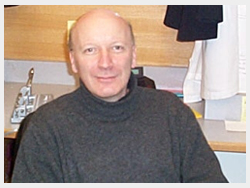Silvio O. Conte Center
Projects and Cores > Photochemistry Core
Core Leader: Graham Ellis-Davies
The study of molecular events in real time in living cells can be accomplished by the integration of light microscopy and bioprobes that can be used to control and monitor cell chemistry. Chemical signals generated inside cells are often highly dynamic in terms of size, spatial range and time course, so that experiments studying such signals must measure and manipulate them in all of these dimensions. Photochemical techniques make use of caged compounds (messenger molecules that are biologically inert) that are activated by light. This offers a uniquely powerful approach for the study of signaling events because it provides precise control of message molecules in a manner independent of the actual production of the message. Additionally, advantages are offered by the photo-control of cell chemistry because the timing, location and amplitude of uncaging are accomplished by a very brief pulse of light, affecting extremely rapid concentration jumps of the caged compounds outside or inside the cell.
The development of new laser-based optical techniques (e.g. the two-photon microscope) often outstrips the invention of new probes that can take full advantage of such technologies. The research in the Photochemical Core, in collaboration with the other neuroscientists involved in the study of the tripartite synapse, focuses on the development of photo-bioprobes. Specifically, the Core is developing and supplying caged compounds and novel caging chromophores: caged neurotransmitters and caged peptides are being chemically synthesized by the Core. In addition we are supplying caged compounds that we have previously developed (caged Ca, IP3, glutamate, GABA).


